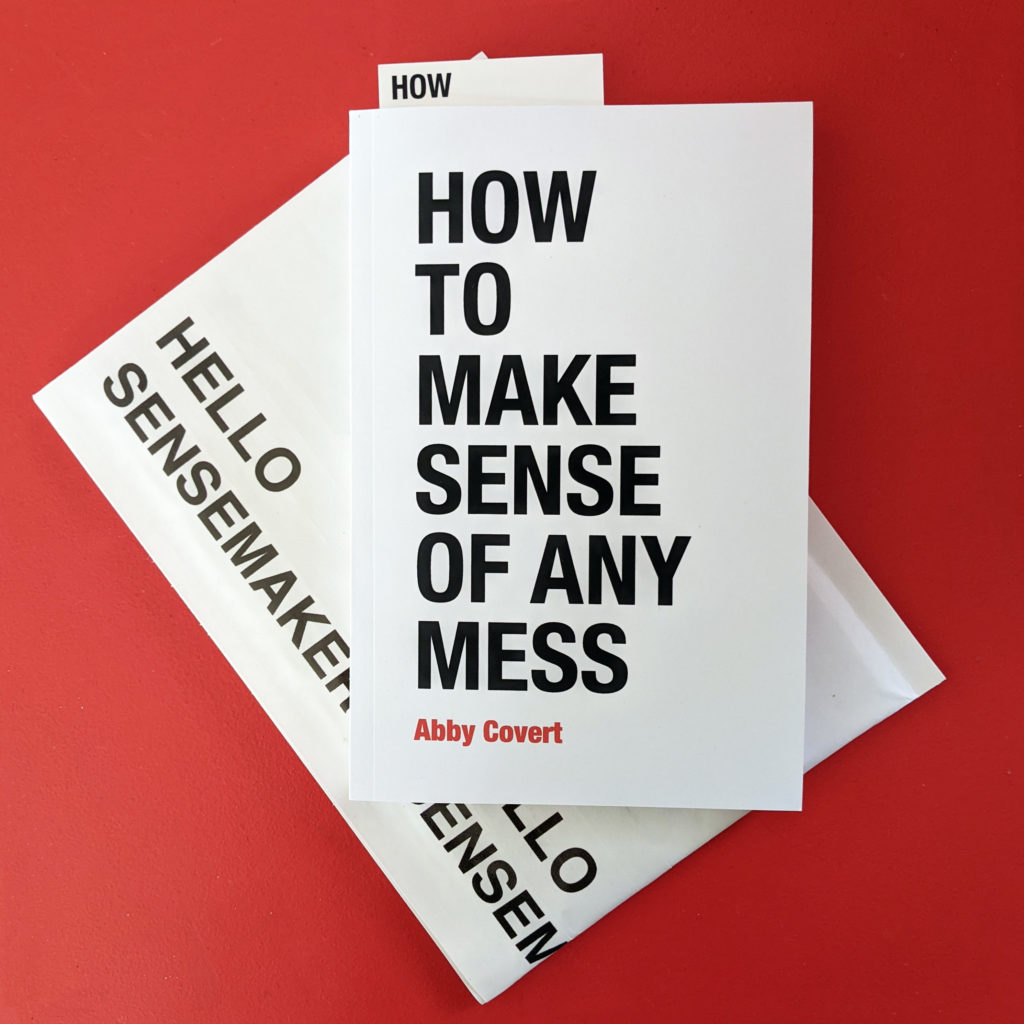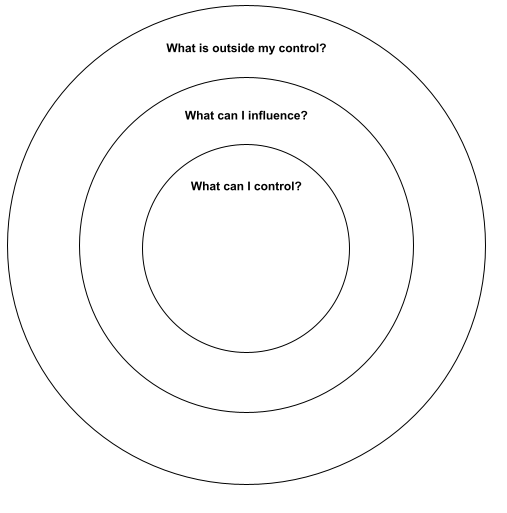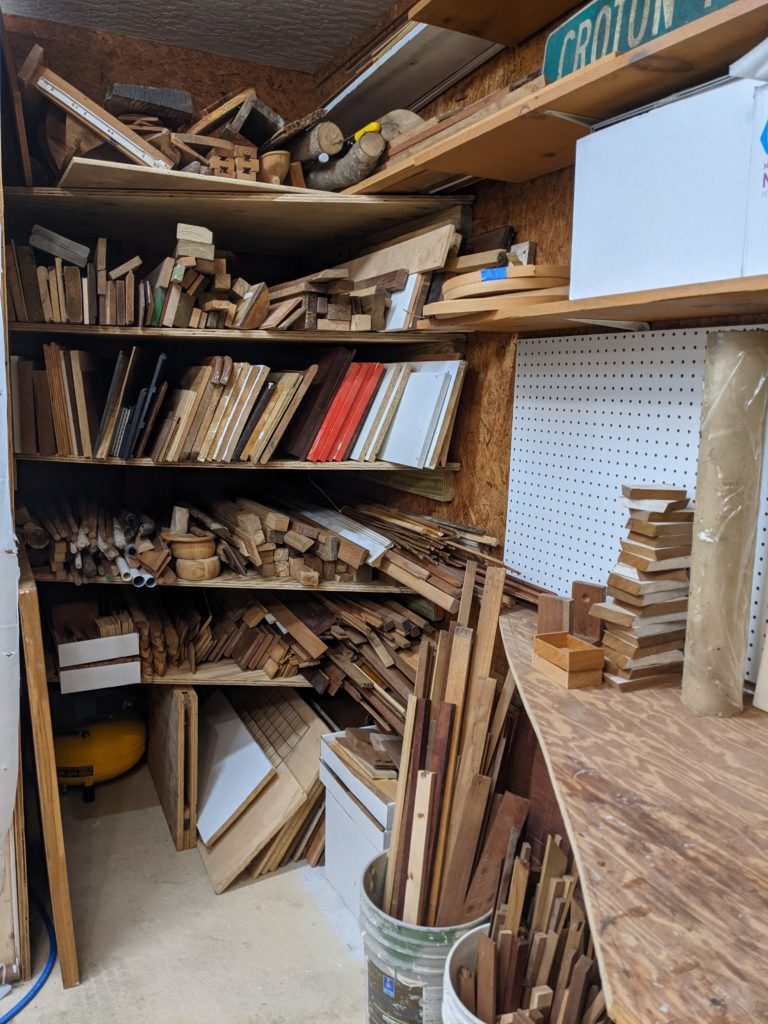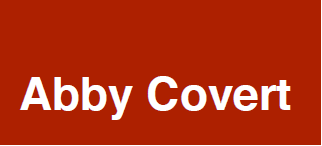Really…Any Mess?
To celebrate World Information Architecture Day 2021, I collected entries in a lottery to win signed copies of my book, How to Make Sense of Any Mess.

In order to enter the lottery, you had to answer one question:
“What is a mess you wish you could make sense of?”
I received 400+ responses, and perhaps unsurprising to anyone who knows me — what started as a cute marketing idea to keep the bots out has turned into a serious curiosity. Perhaps apt given that the theme of World IA Day 2021 was “Designing Curiosity”
In the years since my book came out, I have heard from sensemakers who found themselves in all sorts of messes telling me about their experience making sense.
I have heard about deeply personal messes like publishing a book for a family member posthumously or figuring out the right format for the family schedule / chore board that hangs in the kitchen and keeps a busy family organized.
I have heard about the myriad of gnarly work messes covering everything from the typical toil and complexity of small businesses to the agonizingly complex projects of bigger businesses, civic organizations and nonprofits.
On bad days, it can feel like the messes are all so different. The ambiguity of the differences and the implications of the messiness can stand firmly in the way of us taking on the messes right in front of us, let alone the messes that we have to make many more moves towards before even embarking on sensemaking through.
Sensemaking is lonely work when we think we are different or when we think our mess is un-make-sense-able.
To help support you in that potential loneliness on those bad days confronting whatever messes you have in mind, I want to share the themes I saw in the messes people wrote to me about in my survey along with some sensemaking advice for each theme.
Theme 1: Make sense of my life
Perhaps unsurprising given the 2020/21 of it all, there were a GOOD number of folks who answered my question with some level of cheek-y variation on an answer like “my life” or some more specifically like “my lovelife”, “my brain”, “the chaos that is my mind” — often these responses also featured a smiley or winky face which we all know to mean “kidding, not kidding…HELP ME”
If you are one of these people, hello. I am also you — but only on the days that I draw breath 😉
I spend far too much time thinking about and trying to make sense of my own mind and working on models to better understand the mess that is going on upstairs.
Fear not, while I probably don’t have my brain or life anymore figured out than you do, I do have homework for you that has helped me on days when these messes of the mind feel un-make-sense-able:
Start a Journal.
I’m very serious ~~ but don’t just buy a shiny new journal, fancy pen and think you’re becoming a journal person now only to never actually start because you lose the motivation before your eCommerce order arrives ~~ just pick up a paper-something near you that has at least seven sheets of paper that you can legibly write on with something. DO NOT TYPE THIS – in my experience you will edit yourself more if you type and you will get less from it.
- Everyday for a week write about whatever comes up around the subject you are wanting to work through. Drain your mind, write about your love life, write about the unprocessed garbage stream that is your thoughts first thing in the morning or last thing at night — I speak from experience, not judgement.
- Don’t re-read until the end of the week.
- At the end of the week, re-read your thoughts (I know, ewww)
- Make a messy diagram about what you see.
- Not clear enough yet to inspire action or change? Set aside the diagram and repeat steps 1-4 for another week
High fives to my friend, Ellen Olson Brown for inspiring this activity with her journaling challenge. Her suggested process of writing without rereading and then compiling has changed how I write, and how I process my thoughts.
Why does this work?
Sometimes we need to compile the parts of the mess, on paper and un-judged, before we can start to consider or model out what might make sense to move us forward. By writing about the subject at hand we can sometimes get further than when we are trying to wade through in our mind alone. Also if relieved of a need to structure the mess to think about it, which most visual frameworks require, this writing step can be helpful preparation for being able to draw your mess later on.
Theme 2: Make sense of <insert complex thing that is not in my control>
Climate change, alternatives to capitalism, the UX of finding a job, COVID-19 vaccination inequity… Some people used this survey to tell me about some rather big messes they wish they could make sense of.
If you are one of these people, hello to you. I am also you — especially in the last few years in the wake of the world as the world is. Thinking about how I can (as an information architect, a mom, a writer and a member of my local and global community) impact the BIG things around me keeps me up some nights. From reading the responses of this theme from my survey I’m delighted to at least say I’m definitely in good company.
I’ll be honest, coming up with actionable advice for you was a challenge because it was homework I totally was long overdue in doing for myself.
Identify what you can control and influence.
In thinking about this theme of messes, I remembered a framework called the Circle of Control by Stephen Covey.
I think it might be just the ticket here to get to the center of what we can control in the midst of the bigger, uncontrollable messes we find ourselves involved in. I made some edits in the below version to meet this moment for myself.

- Make three concentric circles and label them as I have above
- Innermost circle: What can I control?
- Center circle: What can I influence?
- Outermost circle: What are things outside my control but that concern me?
- Now, use these circles to dump your brain about that complex thing and your actual relationship to it.
- Keep asking yourself those three questions over and over until it’s all out there on paper, whatever *it* is…
- In the center will be the things you should concern yourself with further, these will hopefully be smaller messes you can tackle with tools or skills available to you
- The center circle will be things you should be giving your time and money to in order to help others to accomplish or change the larger factors and contexts outside your singular control
- The outermost ring is what you can now (if you will let yourself) let go, knowing that you can only impact things outside of your own control or influence through the actions you take within what you can.
Why does this work?
The big messes are so often not fully in our own control (not much is after all) or realm of influence. Therefore an exercise that forces you to sort through what you can control/influence vs. what you cannot can be an eye-opening act of scoping down whatever it is you face to be manageable and approachable. I find this to be the key step people need to take before being able to diagram their reality.
Theme 3: Make sense of <specific industry problem or concept>
Moving between two archaic financial institutions data systems, transitioning our processes to digital for COVID, and my personal fav: The absurd amount of information that is not organised or categorised for my clients
If this is you, welcome to the middle of the beginning. I have been where you are every SINGLE time I am on a big project, without fail.
You have identified the mess, you know what needs to change (at least generally) and now you are looking at the mountain of work ahead to get there. You need to state your intention and get going. But ugh, what a freaking mess?!?!
Ok first, let’s breath. This is hard work. Seeing messes is hard, because once we see them we often can’t unsee them. So they start to eat at us, thinking they can convince us that they are un-make-sense-able.
I am here to give you the secret to messes like these, friends. Right here on this little website — the secret you have been looking for. Ready for it?
You need time.
Not ten minutes between other things, not an hour at the end of your day after the kids are down. Not a Friday afternoon that you blocked out to do “real work” that has slowly been eaten by administrative adulting/doom-scrolling and is now a 35-minute chunk before another meeting someone really really needs to squeeze in (hello people pleasers, I see am you)
I wish I could tell you something different — but nope. You need time. You likely have the know-how, access, permission and skills to make sense of this mess. But dang will it take time and be annoying at times…sigh.
Why does this work?
You need time to look at what is in front of you, think about what you might do about the issues you anticipate and the ways you might get where you need to be with all the people, places and things involved. When we lack time to do this introspection about the problem space, we can stay overwhelmed and never act at all or painfully pull ourselves through it thinking it shouldn’t be so hard.
If you get the time, and you already know enough about your mess, it’s time to choose your words so you can state an intention. With the time and focused attention to think, don’t be surprised when the mess starts to make sense of itself.
Theme 4: Make sense of messes in my environment (digital or physical)
Messy files, the cables under my desk, folders and folders of photos, my garage, the junk drawer, my inbox, my personal website.
If this is you, hello! We are all you at some point, aren’t we? The detritus of the junk drawer or an inevitably messy space is the great equalizer that no person gets to choose their way out of. Even the most organized amongst us can get out of sync with routines or patterns and end up with a mess on our hands.
When this happens, my advice is to have a plan that is about more than should. If you only clean the junk drawer because you think you should, you won’t ever create a structure that you will keep up or the pride to do so.
Get past should and get to work.
- Make sure you aren’t caught in a should storm. Think about the could of it all.
- SHOULD: “This junk drawer should be well sorted because…. Adulting?”
- COULD: “This junk drawer could be like a superhero tool chest of all the whositswhatsits and dodads we need throughout a typical day. Meaning no one will say “Where is the tape measure, tape, screwdriver, scissors, stamps, hand sanitizer et al?” ever again — creating a more peaceful home without friction while finding everyday necessities”
- If you can’t get to the could of it all, maybe you don’t actually need to tidy up this environment to go on living your life perfectly well. Forgive yourself for bothering you with this burden, let it go and find another mess that’s actually in the way of your intention. We only need tidy junk drawers if messy ones make our intentions harder to reach.
- If you can get a could in mind that inspires you to exert the energy, start by removing everything from the space and putting it into a central pile to be sorted from (a key to Marie Kondo’s approach). This keeps us from perpetually starting to tidy with everything in place, while never changing the structures or content that are not serving us or our intention at the moment. This simple approach makes you take a moment, even if brief, with every piece of content.
- Once you’ve dumped the content into a central location, think about the content you have, the space you have and the patterns that might be useful for whatever you are trying to achieve. This is a great time to get some inspiration from others, a tool like pinterest or google image search is so helpful in seeing how other people tackled environmental challenges like cleaning out closets or file systems.
- Brainstorm structures you might use to house the content to best support the intention you have for that space. Take your time to play with different ways before narrowing and executing
- Draw it out first, simple diagrams like schematics can be a great way to consider options and weigh different factors as you render you intention
Why does this work?
Sometimes these kinds of messes of our environment trick us into thinking we have to keep them in a certain way or adhere to a certain pattern
“…because reasons”
BTW this happens in corporate intranet systems and eCommerce sites as often as it does junk drawers, but I digress…
When our reality disagrees with that common sense, the should storm can roll in to shame us about how we should be better organized.
If we meet this kind of should storm with kindness for ourselves, we can channel that energy into making real change to the structures or content that surround us and make up our everyday. We can also channel that energy towards letting it go if keeping things messy isn’t in the way of whatever you are here to do.
I recently took on making sense of the random piles of building materials my husband and father-in-law have been hoarding for the last few years, and I can’t tell you how much up-cycling we have enabled around here as a result.

My intention was to “better merchandise the materials” so we would want to explore them to find new uses. We made a huge pile of it all in the driveway, sorted the pile into general types, then specific ones then built a structure to fit our intention and the space and got to sorting it out. This mess took five years to make and 2 afternoons to make sense of.
No, there is no before picture… I honestly couldn’t stand the mess (or stand back from it) enough to ever capture one.
We all make messes. We all make sense.
I hope read about these four themes and my advice for each was a sort of information salve for whatever mess today brings. Know that we aren’t alone making sense.
Even on the bad days, when the messes seem the most un-make-sense-able, there is some sensemaker somewhere facing or having faced whatever it is in front of us. With the right tools and time, I truly believe that we can make sense of any mess.
Keep in touch.
If you are one of the 400+ people who entered my lottery, thanks for sharing your myriad of messes with me, and especially thanks for being a part of the information architecture and World IA Day community.
Best of luck making sense of whatever mess is next. If you use my advice, let me know how it goes.
If you want to hear about the messes I am making sense of, and not rely on the algorithms I refuse to pay, please consider subscribing to my mailing list by entering your email address below.

